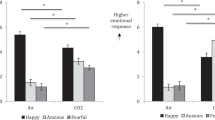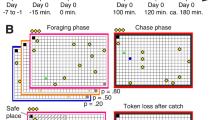Abstract
Rationale
There is interest in the development of augmentation therapy in the treatment of anxiety disorders. Recent publications have shown that d-cycloserine can benefit exposure therapy in a group of acrophobic (height phobic) subjects and in patients with social anxiety disorder. These studies were based on the animal data suggesting that drugs acting to enhance glutamate function may be developed to accelerate the behavioural treatment of anxiety disorders. Perhaps by enhancing glutamate/N-methyl-d-aspartate receptor function, learning is thus enhanced. This study examines the effects of d-cycloserine 50 mg on a task that involves learning. We manipulated anxiety levels to model the effects of high anxiety.
Objectives
To evaluate performance and learning, we used the Manikin task. Two groups of 24 healthy volunteers participated in a double-blind, placebo-controlled study. One group received the inhalation of CO2 7.5% to model high anxiety, and the second group received air to represent lower anxiety. Subjects received d-cycloserine 50 mg or placebo, and the Manikin task was performed during the gas inhalation.
Results
There were significant differences in the group inhaling air, but not CO2, with the d-cycloserine group showing an increase in correct responses. This difference was apparent at several time blocks during the 20-min task. These findings were supported by subjective measures in that participants who received d-cycloserine reported that the task was easier.
Conclusions
We have shown that at lower anxiety levels, d-cycloserine 50 mg improved the performance of this challenging visuospatial cognitive task. This increase in performance was not seen when anxiety was higher, and d-cycloserine did not appear to increase subjective anxiety. These data lend support to the use of d-cycloserine and related glutamate enhancers as cognitive modulators and suggest that the actions of d-cycloserine are not simply related to increased arousal or anxiety.



Similar content being viewed by others
References
Anthony EW, Nevins ME (1993) Anxiolytic-like effects of NMDA-associated glycine receptor ligands in the rat potentiated startle test. Eur J Pharmacol 250:317–324
Argyropoulos SV, Bailey JE, Hood SD, Kendrick AH, Rich AS, Laszlo G, Nash JR, Lightman S, Nutt DJ (2002) Inhalation of 35% CO2 results in activation of the HPA axis in healthy volunteers. Psychoneuroendocrinology 27:715–729
Bailey JE, Nutt DJ (2005) Are personality factors related to the CO2 response in healthy volunteers? J Psychopharmacol 19(5):A18
Bailey JE, Argyropoulos SV, Kendrick A, Nutt DJ (2005) Behavioural and cardiovascular effects of 7.5% CO2 in human volunteers. Depress Anxiety 21:18–25
Bailey JE, Kendrick A, Diaper A, Potokar JP, Nutt DJ (2007) A validation of the 7.5% CO2 model of GAD using paroxetine and lorazepam in healthy volunteers. J Psychopharmacol 21(1):42–49
Beck AT, Steer RA, Garbin MG (1988) Psychometric properties of the Beck Depression Inventory: twenty-five years of evaluation. Clin Psychol Rev 8:77–100
Bell C, Forshall S, Adrover M, Nash J, Hood S, Argyropoulos S, Rich A, Nutt DJ (2002) Does 5-HT restrain panic? A tryptophan depletion study in panic disorder patients recovered on paroxetine. J Psychopharmacol 16(1):5–14
Benson AJ, Gedye JL (1963) Logical processes in the resolution of orientational conflict. RAF Institute of Aviation Medicine, Ministry of Defence (Air), London
Bond AJ, Lader MH (1974) The use of analogue scales in rating subjective feelings. Br J Med Psychol 47:211–218
Bunnell DE, Horvath SM (1989) Interactive effects of heat, physical work, and CO exposure on metabolism and cognitive task performance. Aviat Space Environ Med 60:428–432
Coupland NJ, Bailey JE, Wilson SJ, Horvath R, Nutt DJ (1995) The effects of clonidine on cardiovascular responses to standing in healthy volunteers. Clinic Auton Res 5:171–177
Davis M, Myers KM (2002) The role of glutamate and gamma-aminobutyric acid in fear extinction: clinical implications for exposure therapy. Biol Psychiatry 52:998–1007
D’Souza DC, Gil R, Cassello K, Morrissey K, Abi-Saab D, White J, Sturwold R, Bennett A, Karper LP, Zuzarte E, Charney DS, Krystal JH (2000) IV glycine and oral d-cycloserine effects on plasma and CSF amino acids in healthy humans. Biol Psychiatry 47:450–462
Gibson TM, Allan JR (1979) Effect on performance of cycling deep body temperature between 37.0 and 37.6°C. Aviat Space Environ Med 50(9):935–938
Hearon BF, Brinkley JW (1985) Psychomotor performance after forward-facing impact. Aviat Space Environ Med 56:1043–1051
Hofmann SG, Meuret AE, Smits JAJ, Simon NM, Pollack MH, Eisenmenger K, Shiekh M, Otto MW (2006) Augmentation of exposure therapy with d-cycloserine for social anxiety disorder. Arch Gen Psychiatry 63:298–304
Jordan CS, Farmer EW (1995) The DRA Workload Scales (DRAWS): a validated workload assessment technique. Paper presented at the 8th International Symposium on Aviation Psychology, Columbus, OH
Kalueff A, Nutt DJ (1996) Role of GABA in memory and anxiety. Depress Anxiety 4:100–110
Ledgerwood L, Richardson R, Cranney J (2003) Effects of d-cycloserine on extinction of conditioned freezing. Behav Neurosci 117(2):341–349
Ledgerwood L, Richardson R, Cranney J (2005) d-Cycloserine facilitates extinction of learned fear: effects on reacquisition and generalized extinction. Biol Psychiatry 57:841–847
Leifflen D, Poquin D, Savourey G, Barraud P-A, Raphel C, Bittel J (1997) Cognitive performance during short acclimation to severe hypoxia. Aviat Space Environ Med 68(11):993–997
Nutt DJ, Glue P, Lawson C, Wilson S (1990) Flumazenil provocation of panic attacks: evidence for altered benzodiazepine receptor sensitivity in panic disorder. Arch Gen Psychiatry 47:917–925
Parnas AS, Weber M, Richardson R (2005) Effects of multiple exposures to d-cycloserine on extinction of conditioned fear in rats. Neurobiol Learn Mem 83(3):224–231
Paul MA, Fraser WD (1994) Performance during mild acute hypoxia. Aviat Space Environ Med 65(10):891–899
Reiss S, Peterson RA, Gursky DM, McNally RJ (1986) Anxiety sensitivity, anxiety frequency and the prediction of fearfulness. Behav Res Ther 24:1–8
Ressler KJ, Rothbaum BO, Tannenbaum L, Anderson P, Graap K, Zimand E, Hodges L, Davis M (2004) Cognitive enhancers as adjuncts to psychotherapy: use of d-cycloserine in phobic individuals to facilitate extinction of fear. Arch Gen Psychiatry 61:1136–1144
Richardson R, Ledgerwood L, Cranney J (2004) Facilitation of fear extinction by d-cycloserine: theoretical and clinical implications. Learn Mem 11(5):510–516
Rorick-Kehn LM, Hart JC, McKinzie DL (2005) Pharmacological characterization of stress-induced hyperthermia in DBA/2 mice using metabotropic and ionotropic glutamate receptor ligands. Psychopharmacology 183(2):226–240
Schmidt NB, Mallott M (2006) Evaluating anxiety sensitivity and other fundamental sensitivities predicting anxiety symptoms and fearful responding to a biological challenge. Behav Res Ther 44:1681–1688
Spielberger CD (1983) Manual for the state–trait anxiety inventory (form Y). Consulting Psychologists, California
Swanson CJ, Bures M, Johnson MP, Linden A-M, Monn JA, Schoepp DD (2005) Metabotropic glutamate receptors as novel targets for anxiety and stress disorders. Nat Rev Drug Discov 4:131–144
Van Berckel BNM, Lipsch C, Timp S, Gispen-de-Wied C, Wynne H, van Ree JM, Kahn RS (1997) Behavioral and neuroendocrine effects of the partial NMDA agonist d-cycloserine in healthy subjects. Neuropsychopharmacology 16(5):317–324
Walker DL, Ressler KJ, Lu K-T, Davis M (2002) Facilitation of conditioned fear extinction by systemic administration of intra-amygdala infusions of d-cycloserine as assessed with fear-potentiated startle in rats. J Neurosci 22(6):2343–2351
Woods SW, Charney DS, Goodman WK, Heninger GR (1988) Carbon-dioxide-induced anxiety: behavioral, physiologic, and biochemical effects of carbon dioxide in patients with panic disorders and healthy subjects. Arch Gen Psychiatry 45:43–52
Yurgelun-Todd DA, Coyle JT, Gruber SA, Renshaw PF, Silveri MM, Amico E, Cohen B, Goff DC (2005) Functional magnetic resonance imaging studies of schizophrenic patients during word production: effects of d-cycloserine. Psychiatry Research. Neuroimaging 138:23–31
Acknowledgement
Part of this work was funded by the Human Science Domain of the UK Ministry of Defence Scientific Research Programme for which the Manikin task was provided solely for the purpose of this grant. We also thank Dr A. Diaper for assistance in the CO2 study and to all the volunteers who participated.
Author information
Authors and Affiliations
Corresponding author
Rights and permissions
About this article
Cite this article
Bailey, J.E., Papadopoulos, A., Lingford-Hughes, A. et al. d-Cycloserine and performance under different states of anxiety in healthy volunteers. Psychopharmacology 193, 579–585 (2007). https://doi.org/10.1007/s00213-007-0817-9
Received:
Accepted:
Published:
Issue Date:
DOI: https://doi.org/10.1007/s00213-007-0817-9




